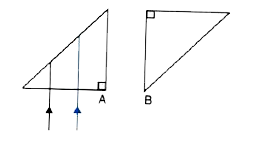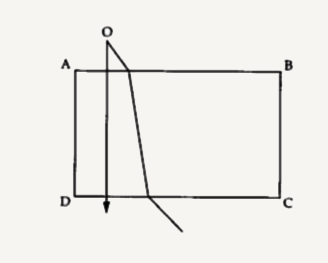In Figure, a monochromatic point source of light S is viewed by an observer O through a prism P. complete the diagram to show the image formed by the prism and as seen by the observer O. label the image by the letter I.

The completed ray diagram is shown in figure. Two rays SA and SL from the source of light S, are incident on the prism. They are refracted along AB and LM respectively from the first face of the prism. The rays AB and LM again get refracted from the second face of the prism and emerge out of the prism along BC and MN respectively such that they appear to come from a point I. thus I is the image of the point source S. in other words, the observer O sees the source S raised to the position I.

Topper's Solved these Questions
- REFRACTION OF LIGHT AT PLANE SURFACESBook:ICSEChapter:REFRACTION OF LIGHT AT PLANE SURFACESExercise:EXERCISE-4(A)
Explore 31 Videos
- REFRACTION OF LIGHT AT PLANE SURFACESBook:ICSEChapter:REFRACTION OF LIGHT AT PLANE SURFACESExercise:EXERCISE-4(A) MULTIPLE CHOICE TYPE
Explore 3 Videos
- REFRACTION OF LIGHTBook:ICSEChapter:REFRACTION OF LIGHTExercise:DIAGRAM BASED MCQ:
Explore 5 Videos
- REFRACTION THROUGH A LENS Book:ICSEChapter:REFRACTION THROUGH A LENS Exercise:EXERCISE-5(D) (MULTIPLE CHOICE TYPE)
Explore 2 Videos
Similar Questions
An object is viewed through a glass prism with its vertex pointing upwards. Draw a ray diagram to show the formation of its image as seen by the observer.
View SolutionFig. shows a thin beam of white light from a source S striking on one face of a prism.

(a) Complete the diagram to show the effect of the prism on the beam and to show what is seen on the screen.
(b) If a slit is placed in between the prism and the screen to pass only the light of green colour, what will you then observe on the screen?
(c) What conclusion do you draw from the observation in part (b) above?
View Solution(a) Figure shows two isosceles right angled prisms A and B and the light rays incident on the prism A. complete the diagram to show the rays emerging out of the prism B.
(b) State the principle used for completing the ray diagram in part (a) above.

View SolutionIn the figure shown, how many images of the star will an observer at O see?
_E01_006_Q01.png)
View SolutionWhich of the following equation is correct in the context of kohlarusch 's law
View SolutionA point source of lightS is placed in front of two large mirros as shown .Which of the following observes will see only one image of S?

View SolutionA monochromatic point source of light O is seen through a rectangular glass block ABCD.
Paths of two rays, in and outside the block, are shown in the figure below.

Justify your answer with the help of an appropriate ray diagram as shown in figure.
View SolutionA monochromatic point source of light O is seen through a rectangular glass block ABCD.
Paths of two rays, in and outside the block, are shown in the figure below.

How does the shift depend on the thickness (AD or BC) of the block?
View SolutionA monochromatic point source of light O is seen through a rectangular glass block ABCD.
Paths of two rays, in and outside the block, are shown in the figure below.

Does the source at point O appear to be nearer or farther with respect to the surface AB?
View Solution
In figure, a ray of light PQ is incident normally on the face AB of an equilateral glass prism. Complete the ray diagram showing its emergence into air after passing through the prism. Take critical angle for glass=42∘.
(a) Write the angles of incidence at the faces AB and AC of the prism.
(b) Name the phenomenon which the ray of light suffers at the face AB, AC and BC of the prism.
View Solution

